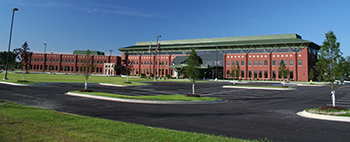Retrocommissioning Helps Hospital Maximize Efficiency
 TIFFIN, Ohio — Facility managers know that operating a newly constructed building in the real world often tests systems in unexpected ways. Charles Ervin, director of facility and support operations for Mercy Tiffin Hospital, located in Tiffin, Ohio, lived this experience first-hand.
TIFFIN, Ohio — Facility managers know that operating a newly constructed building in the real world often tests systems in unexpected ways. Charles Ervin, director of facility and support operations for Mercy Tiffin Hospital, located in Tiffin, Ohio, lived this experience first-hand.
“When we built the new hospital, our intent was to build maximum energy efficiency into all of its major systems — lighting, HVAC and more,” he said. “But that’s before you have the chance to put the building to use. Now we have experience with the facility, with its everyday use and we have learned that there are ways for us to further maximize efficiencies by refining those systems.”
Mercy Tiffin, a 193,407-square-foot facility with 54 patient rooms, was constructed with Energy Star-rated equipment and the latest environmental building practices. But as Ervin and his team discovered, the hospital could do more to reduce its carbon footprint and maintain the facility’s leading-edge patient services.
From Commissioning to Retrocommissioning (RCx)
Commissioning a building during the construction phase is a formal process that ensures that targeted building systems are brought online and calibrated for optimum use.
“We spent the first year or two just getting to know the building, how to maintain it and how we can improve temperature and lighting control,” said David Recker, manager of facilities operations. Four years (and lots of operational experience) later, the Mercy Tiffin team was ready to take the next step. It was time for a retrocommissioning (RCx) study.
The RCx Phase Identifies New Opportunities
In late 2011, Mercy Tiffin turned to Powell, Ohio-based Professional Commissioning Services (PCS) for help. The facilities team wanted to increase both energy and operational efficiency. First, the Mercy-PCS team worked together to establish goals for the project. Then, PCS analyzed the building and its ancillary systems over 10 days and nights to obtain the necessary data. PCS staff reviewed major mechanical systems including the chiller plant, air distribution system, DX air conditioning system and lighting controls. This work identified heat loss from the building envelope, temperature and air-flow measurements. PCS then combined this data with interviews with building occupants, which was a critical step.
Using this information, PCS staff produced a report for the Mercy Tiffin team to review. It contained many no-, low- and moderate-cost actions, a number of which had immediate paybacks.
Taking Smart RCx Actions Now
This process identified 35 facility improvements and operational practices that could be changed.
“Places like nutrition services, certain administrative areas and some store rooms aren’t used around the clock,” Recker said. “We can save $32,000 a year with a few months payback by smartly heating, cooling and lighting those spaces and scheduling setbacks in areas that aren’t occupied 24/7.”
“The same goes for our boilers,” he added. “They were set at a certain temperature year-round. We simply adjusted some of the building’s automation controls to reduce costs and save energy. This step will save $49,000 a year with a payback in eight months. We have great infrastructure in our hospital — we just have to take better advantage of what we have.”
Budget Matters
As Recker explained, the facilities team is “implementing things right now that are no-cost or low-cost measures.” RCx changes that require capital expenditures are being prioritized for future consideration. “Some of these longer term projects won’t happen overnight, but they will happen,” Ervin concluded. “This investment in time will pay dividends as we reduce our carbon footprint and promote sustainability, part of our mandate from our parent company, Catholic Healthcare Partners.”
Mercy Tiffin conducted this RCx study with the help of AEP Ohio and the Ohio Hospital Association (OHA). Mercy Tiffin, part of its northwest Ohio community for nearly a century and its new facility, opened in 2008, was built to assure its presence for the next 100 years. The hospital is home to as many as 115 beds, has 300 full-time employees, an attached 50,000-square-foot medical office building, both inpatient and ambulatory surgical services and much more to serve the 18,000 residents of Tiffin and Seneca County.
Andrew McCabe is the manager of energy efficiency and peak demand reduction programs for the commercial and industrial customers served by AEP Ohio, an Ohio and West Virginia electric power provider.
